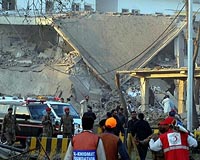| . |  |
. |
Aboard An Afghan Air Force Helicopter, Afghanistan (AFP) July 8, 2010 "They shouldn't be flying if it's doing that, should they?" said US Captain Sean Masters. "I wouldn't fly it." About 3,500 feet (1,000 metres) above troubled south-central Afghan province Ghazni, the US air force adviser had just been told that the Russian-built helicopter flying alongside appeared to be having engine problems. The engine gauge was swerving up and down, Afghan Air Force pilot Abdul Basir radioed from his camouflage-painted Mi-17. Both agreed the problem should be checked at the next stop, a base in the town of Gardez. Afghanistan is battling to upgrade its fleet which flies troops and government officials around the country as part of US-led NATO plans to quicken an end to the nine-year war against the Taliban. But as the pair landed at an Afghan military base, the scope of the challenges facing even just one helicopter became clear. The base commander swept onto the tarmac and began to argue with Basir, insisting that the helicopters fly on schedule to ferry troops already late for deployment into a war seen by many analysts as swinging towards the Taliban. "These 200 guys just finished their training and were supposed to go to different provinces. But because of problems with aircraft, they have been delayed five days," he said. With the country's rugged terrain and roads pockmarked with militant bombs, air support is vital in the fight for Afghanistan. But Basir, who said he has "flown in every kind of situation" with more than two decades of experience, refused to take off. "I'm not going to be responsible for their deaths," Basir said. "Only technicians can understand this problem." Even before the engine trouble, the mission ran into snags. An early morning departure from Kabul was delayed because the helicopters arrived late, and a previously unannounced Afghan military delegation was scheduled at the last minute to join the trip. Washington provides aircraft and trainers, and Masters said relations with their Afghan counterparts can sometimes run into "cultural differences". One example, he said, was that the Afghan air force placed a higher priority on returning bodies than evacuating wounded. "The requirements of Islam to return a body within 48 hours will quite often trump a medevac," Masters said. And hardware issues are putting the corps under strain, said Lieutenant Colonel Ahaj Bakhtullah, at a time when counter-insurgency operations are being ramped up to push the Taliban out of its southern heartland of Kandahar. "We have an increase in flights, but we don't have enough helicopters. Some of them are broken and some of them are under maintenance," Bakhtullah said. Afghan Air Force commanders say they have 19 working Mi-17s that transport Afghan troops, government officials and equipment, as well as evacuate Afghan casualties and bring back human remains. There are plans to further increase the fleet and establish a pilot training centre in the western province of Herat as part of the effort to get the Afghan military on its feet so international forces can leave the country. Mi-17s are part of a fledgling 52-aircraft fleet that also runs some combat missions, but is a shadow of its former glory. At the time of the Soviet occupation in the 1980s, Afghanistan had several hundred military aircraft: transport and attack helicopters, fighter jets, bombers -- enough air power to worry its neighbours. But after the retreat of the Soviets, the fleet was rapidly reduced to a handful of aircraft controlled by the anti-Soviet Northern Alliance under the late Ahmad Shah Massoud and then the Taliban regime. Afghanistan expects to take delivery of another 10 Mi-17s by October, although the plan has faced criticism from US members of Congress who wanted US-made helicopters to be used by local forces. Russian helicopters are being used because many of the 92 Afghan pilots are products of the Soviet flying school. Despite the engine problems, Masters said the helicopter, designed for Afghanistan, was perfect for the conditions. "It's a monster" he said. "It carries a lot of stuff."
Share This Article With Planet Earth
Related Links News From Across The Stans
 China, Pakistan vow to step up fight against terrorism
China, Pakistan vow to step up fight against terrorismBeijing (AFP) July 7, 2010 China and Pakistan pledged to step up joint efforts against terrorism Wednesday as the presidents of the two neighboring nations vowed to expand trade and economic cooperation, state media said. Chinese President Hu Jintao welcomed Pakistani President Asif Ali Zardari to the Great Hall of the People where the two leaders expressed their commitment to deepening ties in energy, communications ... read more |
|
| The content herein, unless otherwise known to be public domain, are Copyright 1995-2010 - SpaceDaily. AFP and UPI Wire Stories are copyright Agence France-Presse and United Press International. ESA Portal Reports are copyright European Space Agency. All NASA sourced material is public domain. Additional copyrights may apply in whole or part to other bona fide parties. Advertising does not imply endorsement,agreement or approval of any opinions, statements or information provided by SpaceDaily on any Web page published or hosted by SpaceDaily. Privacy Statement |